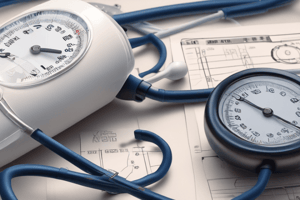Podcast
Questions and Answers
What is the primary parameter influenced in the heart after postural changes, exercise, and the dive reflex?
What is the primary parameter influenced in the heart after postural changes, exercise, and the dive reflex?
- TP interval (correct)
- P wave width
- QT interval
- QRS wave width
How does the autonomic nervous system respond during postural changes regarding heart rate?
How does the autonomic nervous system respond during postural changes regarding heart rate?
- Enteric nervous system activation
- Somatic nervous system activation
- Parasympathetic nervous system activation (correct)
- Sympathetic nervous system activation
During exercise, why does systolic pressure increase more than diastolic pressure?
During exercise, why does systolic pressure increase more than diastolic pressure?
- Increased arteriole constriction during systole
- Enhanced activation of Parasympathetic nervous system
- Need to supply more blood to exercising muscles (correct)
- Decreased blood flow to exercising muscles
What is the physiological response of the dive reflex on heart rate?
What is the physiological response of the dive reflex on heart rate?
What is the main cause of heart sounds heard during cardiac cycles?
What is the main cause of heart sounds heard during cardiac cycles?
What happens to vessel diameter during reactive hyperemia?
What happens to vessel diameter during reactive hyperemia?
What is the first sound you hear when measuring blood pressure with a stethoscope?
What is the first sound you hear when measuring blood pressure with a stethoscope?
Why is systolic pressure typically higher than diastolic pressure?
Why is systolic pressure typically higher than diastolic pressure?
Which segment of an ECG tracing indicates ventricular depolarization?
Which segment of an ECG tracing indicates ventricular depolarization?
What does the T wave represent in an ECG tracing?
What does the T wave represent in an ECG tracing?
Flashcards are hidden until you start studying




